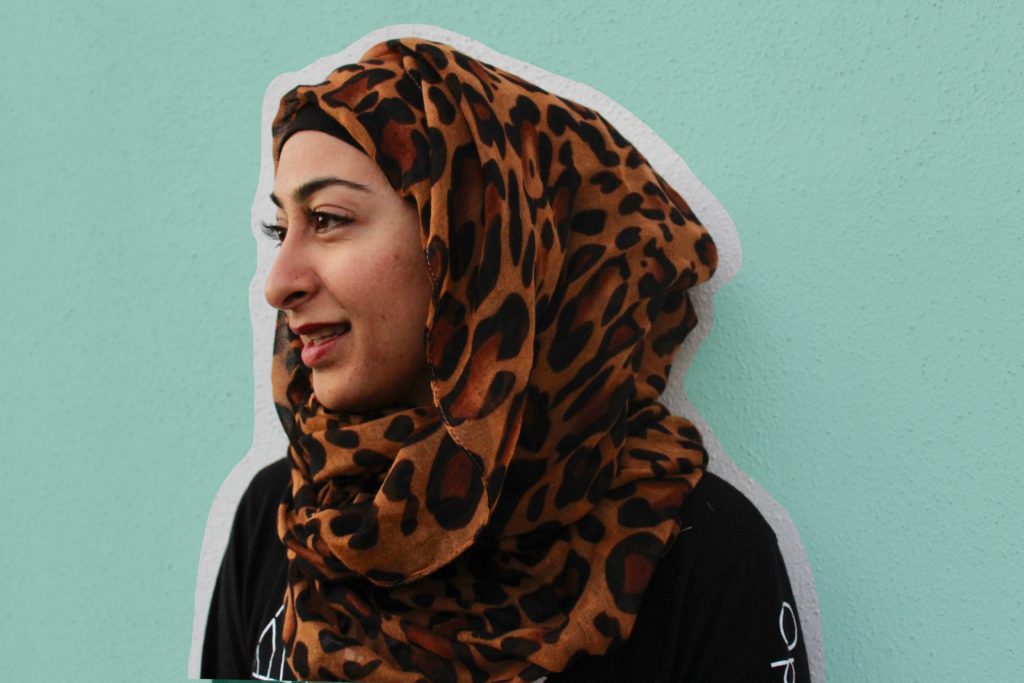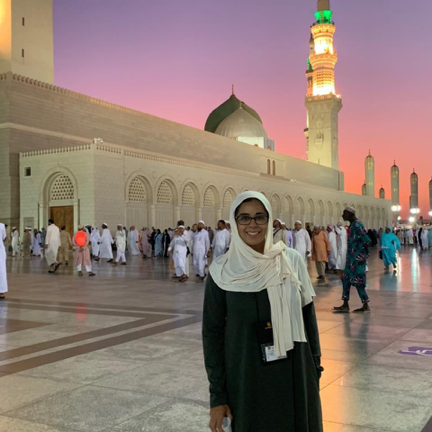Three Austin women address misconceptions about why and how they wear hijabs.
By Abby Hopkins

Muna Hussaini – Photo by Abby Hopkins
Uneducated, stuck at home, forced, oppressed: Muna Hussaini has heard these descriptors used to characterize women who choose to wear hijabs but with a successful career in tech and two decades of wearing her scarf, she begs to differ.
Muslim women often face misconceptions about why and how they wear hijabs. From assuming the hijab is restrictive to guessing it’s as simple as putting a scarf over one’s head, each stereotype misses the mark and neglects to understand and recognize each hijabi’s individual journey and style differences.
Hussaini started wearing a hijab in 2000 as a junior in college. After meeting accomplished, intelligent and athletic women who wore hijabs without hindrance, her curiosity piqued. She started to understand their reasoning as she got to know them and researched the topic individually, leading to her decision to wear one.
A year later, 9/11 happened. Hussaini took off her hijab the next day because of her parents’ concern but felt naked without it, so she quickly returned to wearing it. Soon after, a coworker barged into her office with threats to her family and other Muslims. It was just one of the many hate crimes Hussaini experienced, yet she continued wearing her hijab.
“I don’t know how to be anything other than what I am,” Hussaini says. “I’m not going to change myself out of fear.”
Her parents raised her to be herself and disregard what other people thought of her, and while they didn’t force her to wear a hijab, they encouraged it. She said deciding to wear it was her own choice.
“I had a chance to take it off, but there’s a cognitive dissonance when something’s inside you and something’s in your soul—I have to be it,” Hussaini says. “Otherwise, I would feel lost. At the end of the day as a Muslim, I’m not here to please anyone else. I’m here to serve my Lord and submit, and there’s a peace in that.”
This freedom to be herself allows Hussaini to style her hijab how she likes it and fix her hair up when her friends throw women-only parties.

“Just because Muslim women wear a scarf, they still do their hair,” Hussaini says. “They get it dyed, they get it cut, they do everything. Women will go out of their way to have their own events where they can dress up and live it up.”
This sisterhood of hijabis is important to Farhana Khawar, who also began wearing a hijab in college after befriending other women who did so. She grew up Muslim but didn’t know much about the hijab’s meaning; her family members who wore it did so for cultural reasons. As she began digging deeper into her faith, she knew she wanted to get closer to God but didn’t know what it looked like in action.
On a bad hair day, Khawar wore a bandana, and people asked if she was starting to wear a hijab. This happened a few times until she decided to read what the Qur’an said. She didn’t want to be spoon-fed or take anything at face value.
“It was a very careful decision, and it was going to speak to me, and I was going to wholeheartedly accept,” Khawar says. “I started to wear it knowing that God has blessed me with so much in my life, and I also realized women did wear the scarves and they still were respected and in high positions.”
For her, the hijab represents a spiritual journey, and she says she doesn’t want others to feel lesser than if they don’t wear it.
“I’m not better than anyone,” Khawar says. “What will prove my worth is how I treat others and how I conduct myself and deal with somebody behind closed doors. How does my character define me? Not, how does this piece of cloth define me?”
For Anjum Hanafi, choosing to wear a hijab was a longer journey. This year, Hanafi went on hajj, a required pilgrimage to Mecca, Saudi Arabia Muslims take at least once in their life if they are financially and physically able. She went alone to immerse herself in worship and prayer.
“From a societal perspective, you are completely unproductive,” Hanafi says. “I certainly wasn’t contributing to society in any meaningful or purposeful way while I was there, yet it was, by far, the most purposeful two weeks of my entire life.”

She kept hearing about how oftentimes people ask God for things they want without demanding anything of themselves to give back. It resonated with her and led her to ask herself what she was asking of herself for God.
She wore a hijab while there and, on the way back, talked herself into keeping it on, but in small steps to not get overwhelmed. She had always considered wearing a hijab, but she never followed through until her journey home from hajj.
Since she returned, Hanafi says she has received only positive responses from both Muslims and non-Muslims, but one thing many don’t realize is the thought and time it goes into wearing a hijab.
“It’s an accessory with more meaning than just style,” Hanafi says. “It’s good to be able to show people we’re wearing these scarves, but that doesn’t mean there isn’t a fashion component to it, or we don’t care about how we look.”
Women can individualize their hijab look by picking out different fabrics or patterns and using additional accessories like underscarves, pins and volumizers to style the scarf a certain way. For some, like Hanafi, shopping for scarves and watching tutorials is a way to make the hijab experience enjoyable and fun. For others, sticking with a simple black scarf is their go-to.
However a woman chooses to style her hijab, or if she doesn’t wear one at all, Khawar thinks it’s important for all women to unite and empower one another because it’s the inside that counts.
“Regardless of what you wear, people should not be judged on that,” Khawar says. “People should be seen for the beauty within us and the difference we make in this world.”
HIJABI HAIR CARE
Muna Hussaini
Biggest hair struggle: hair thinning, keeping stay hairs under scarf and shopping for scarves
Favorite products: volumizer, pins and an underscarf
Farhana Khawar
Biggest hair struggle: hair thinning and her habit of tying hair immediately after showing leading to migraines
Go-to style: turban
Favorite products: oils and an underscarf
Anjum Hanafi
Biggest hair struggle: figuring out the ins and outs of wearing a hijab
Favorite products: volumizer and an underscarf

